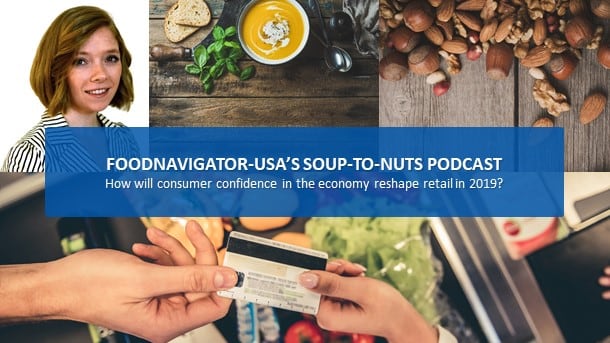The report, which was released today, draws on insights from nearly 5,000 experts and practitioners in the food and beverage industry to forecast the top ten food and nutrition trends for the upcoming year, including several that center on clean products, clear labeling and truthful marketing.
For example, the report predicts that consumers will push back against “food porn” that cherishes highly-stylized and perfect-looking food, and instead favor “ugly” foods that are misshapen or flawed in some way.
“This will bring people much closer to food, partly because a majority of natural foods are harvested with an ‘unusual’ shape, and people are trying to go ‘back to basics,’ by appreciating the food as it is, and focusing less on how it looks,” Lena Halabi, KIND’s senior food scientist, told FoodNavigator-USA.
She explains this movement brings significant marketing potential for brands and products that embrace it.
“Harvesting funny-looking fruits and vegetables also gives people something to talk about on social media, as people get creative with photography and turning them into dishes,” she said. “Additionally, I think less ‘pretty’ photos of meals will connect people better to cultures and to one another. Some homemade dishes don’t look great, but are so flavorful and delicious. This will give people an opportunity to talk about the food, and its origins, versus fetishizing on how it looks and trying to conform to a mainstream expectation of food appearances.”
An extension of this trend will be a “food-first” mindset that favors whole foods over vitamins when possible, the report predicts.
According to the report, consumers are starting to embrace “whole, minimally processed foods to meet their nutritional needs,” which means “moving away from heavily fortified products and replacing them with whole options that are inherently nutrient-rich.”
Building on this, transparency 2.0 is a third trend to watch in 2019, according to KIND. It explains, “This past year, we saw transparency make its way onto the nutrition label, ingredient list and even marketing claims,” but “in 2019, we will see transparency shape companies’ cultures, hiring practices and inclusion measures.”
Consumers become more sophisticated about sugar
One of the changes to the nutrition label that came out of the first wave of demand for increased transparency was the requirement to break out added sugars – a relatively complex concept, which as consumers better understand is pushing them to shift their ‘anti-sugar’ mentality to a more nuanced ‘anti-added sugar’ approach, according to the report.
“Consumers are becoming more aware that not all sugars are created equal,” and of research showing that dietary patterns lower in sugar-sweetened foods and beverage could reduce the risk of heart disease, according to the report.
KIND has been a frontrunner on this trend, announcing three years ago in 2015 that it would reduce added sugar in seven of its original Fruit & Nut bars, Stephanie Perruzza, the company’s health & wellness specialist, told FoodNavigator-USA.
“Subsequently, we also reduced sugar in four additional nut-based bars, which resulted in our new formulas having 14-57% less added sugar. We finalized those updates in 2017, but always continue to challenge ourselves on ways to minimize added sugar in our snack recipes or not to include it as an ingredient like our Pressed by KIND bars,” she noted.
Sugar reduction fuels flavored water sales
Consumer push-back against the amount of sugar they consume also will drive another trend that KIND predicts will gain traction next year: “H2-WhOa.”
According to the company, “While infusing water with fruits and vegetables is common for many Americans, we anticipate other forms of hydration to gain popularity,” such as “maple water, which contains less than half the sugar of coconut water, as well as cactus water, which is promoted for skin revitalization.”
‘Going meatless isn’t just for Mondays’
Added sugar isn’t the only thing that consumers will continue to cut back on in the New Year – they also will continue to step away from animal-based products and embrace meatless alternatives, according to the report.
“From plants to insects and lentils to soy, meat and dairy-free protein alternatives are becoming more mainstream,” KIND notes. “We expect to see more innovations highlighting nuts, extruded seeds, beans, water lentils and algae across categories, such as snack bars, chips, meat-free burgers or sausages and dairy-free yogurts and cheeses.”
Fats and fiber are in
While added-sugar and animal protein may be on the way out, healthy fats and fiber are on the way in, according to the report.
In particular, the report suggests that seed butters, such as from sunflower, pumpkin and watermelon seeds, will capitalize on consumer interest in healthy fats while also providing options for allergy-sufferers. This will build on the nut butter craze that swept the industry this year.
Fiber also will enter the spotlight as more consumers focus on improving their gut health as a key to better overall health, according to the report.
“Look for even more products to tout the gut health trio of fiber, prebiotics and probiotics,” and for food labels that indicate they are good source of fiber with claims of meeting the daily value of 10% or more of fiber, the report adds.
Fast-growing niche trends
A few of the trends listed by KIND are more niche – but are fast-growing.
For example, KIND predicts that 2019 will be the year cannabis plant extracts make their way into food and beverages, such as yogurt, soup and salad dressing.
“Many Americans live stressful lives, and I think CBD will be seen as a natural way to relax and disconnect from it all,” said Halabi. “Some craft cocktails have similar ingredients, like valerian root, kava kava and lavender, as a way to unwind and reduce anxiety.”
Perhaps a bit more niche, the report also predicts African-inspired culinary influences will make their way in more conventional formats, including harissa, berbere, dukkah, ras el hanout and tiger nuts.




